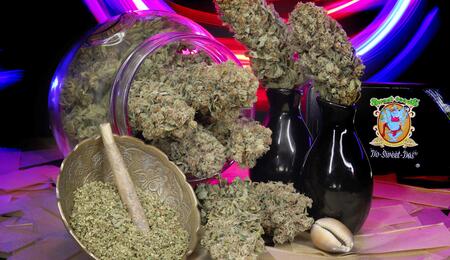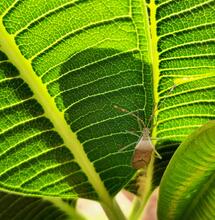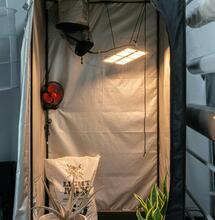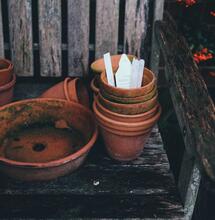Indoor growing with an expandable LED kit

We talked to MesMais, a long-time indoor home grower known for his test crops in the cannabiscafe.net forum. He has been testing several crops with the Photosystem LED lighting system, which stands out for its excellent performance and quite inexpensive price. In addition, it is highly modular, meaning you can start growing with a single LED and then increase lighting units as required, whenever appropriate. Never before has quality LED lighting been so affordable. The photos shown in this report are from his test crop of Sweet Seeds’ Do-Sweet-Dos.
A test crop of Do-Sweet-Dos
Druida. Photos: MesMais
MesMais is a veteran Cannabiscafé forumer, registered in 2003. He says: “As a hash user, I was very interested in learning more about this plant. I wanted to stop encouraging the drug trade and take better care of my health. I think I remember my brother telling me one day that there was cannabiscafe.net and I didn’t hesitate for a second to register, seeing how good the atmosphere was. Cannabiscafe was then the largest online encyclopaedia of cannabis which I could learn from; great growers, the best, and people very committed to legalisation, with a great desire to understand and share knowledge.”
Lighting
After years with HPS and then with LEC, he always thought it was not worth making a big investment with LEDs, he was not willing to change. With the help of his Cannabiscafe buddies and seeing the results of growers using LEDs from Photosystem, he opened his eyes. The investment was not that high and advantages were many; more lighting units, lower temperature, lower costs and greater service life. When Photosystems opened a room in Cannabiscafe.net, he read a lot about the LEDs in their catalogue and eventually decided to buy a very easy-to-assemble kit, which was then extended. [caption id="attachment_37753" align="alignnone" width="1920"] Growth with a fluorescent lamp and a LED strip in a mini-tent.[/caption] Depending on the growing stage and size of the plants, he usually starts with 4000K LEDs, placed at a greater distance. On changing the photoperiod, he adds 2700K, thus also varying the light spectrum a little. In this case, he began with 4 CRI 97 4000K of 50W. When he changed the photoperiod, he increased the lighting with another CRI 97 2700K unit of 50W and, after a few days, when blooming started, he upgraded the system with 4 CRI 97, each of 30W. Although, in the case of LEDs, it would be preferable to measure micromoles (μmol) rather than lumens, he always uses a luxmeter for reference. [caption id="attachment_37754" align="alignnone" width="1920"] Do-Sweet-Dos growth.[/caption] In this test crop, a case of false albinism appeared, that is to say, a plant had a white tip without actually being an albino. It was just a specimen in the middle of the grow-tent, which received light from all sides. In addition, for a couple of days, he used a 50W LED at a very short distance and so he thought this was due to an excess of light radiation. The problem was solved by an adjustable controller he used to reduce power to 30W (and therefore avoid excess light).
Do-Sweet-Dos
For this crop, he used Sweet Seeds’ Do-Sweet-Dos. This strain originates from a Girl Scout Cookies descendant, i.e. the OG Kush Breath, crossed with Face-Off OG. The final hybrid is very OG-influenced, with a distinctly American flavour and high production of trichomes resulting in a powerful effect. It is easy to grow and yields very dense buds. [caption id="attachment_37755" align="alignnone" width="1920"] A ‘still life’ picture of Do-Sweet-Dos after harvest[/caption] During flowering, the specimens ended up forming beautiful, elongated, hard and resinous ‘truncheons’. MesMais commented that the plant was “easy to grow, stable, undemanding, generous and satisfactory to harvest. I would say it is resistant to powdery mildew and botrytis.”
Installation
Following his original philosophy, MesMais has always sought clean and ecological self-sufficiency, with crops as healthy as possible and without many complications. He generally uses a couple of grow-tents, a few LEDs, two fans, heaters, a dehumidifier, an extractor and passive air-suction. [caption id="attachment_37757" align="alignnone" width="1920"] Pruned low branches[/caption] In the first 15/30 days, plants are kept in a grow-tent sized 50x50x50 cm, with two 55W fluorescent lights. When necessary, he adds a couple of LED strips. This makes the first growing stage of the plant easier. Here plants can continue growing while the larger tent is occupied by the maturing plants. This latter tent – used for the last days of growth and the entire flowering stage – is sized 80x80x160 cm and equipped with LEDs. Here MesMais grows nine plants in fabric pots.
Climate
Grow-tents are placed outside his house, in the courtyard, an area with extreme weather, so it is very difficult to keep temperature and humidity stable. Some days temperature can reach a minimum of 5º C and others a maximum of 34ºC and humidity that can vary between 40% and 80%. Therefore, his crops are always affected by the local climate, whether it is autumn, winter or spring. This forces him to adjust air extraction, heating, humidity and ventilation in order to maintain a suitable environment.
Pruning and use of meshes
During the cultivation, he prunes low branches and buds several times. Pruning low branches facilitates irrigation or any other action that has to be done in the substrate, such as fertilisation or cleaning. Pruning branches can also help the plant form better upper buds. Indoors, the lower parts do not flower with the same strength and are often used for extracts. To avoid a lot of loss, MesMais also removes buds in the lower part. This operation has the same purpose as pruning, i.e. avoid wasting time and help the plant focus its energy on the branches and buds that need to be enhanced, as the penetration of light is lower than in outdoor cultivation. “Once you know the size it will reach, all that grows underneath means a waste of time and production”, observes MesMais. [caption id="attachment_37758" align="alignnone" width="1920"] Vegetative phase under Photosystem LEDs.[/caption] He uses a simple and effective removable mesh system, with elastic bands and beverage can pull-tabs. The purpose of this protection is to avoid driving stakes into the substrate and accidentally cutting through a few roots. As he says: “I had an idea of something like a removable mesh, to make my job easier when I need to take the plants out of the grow-tent. I thought that pull-tabs could be useful to fasten the branches to a rubber band, so that they do not bend under the weight, and also hold the bands in position. The mesh can be quickly put on and taken off without damaging anything”.
Fertilisation and precautions
In line with his goal of growing marihuana as naturally as possible, MesMais uses few environment-friendly fertilisers. In addition to adding a fertiliser to the irrigation water, he adds Top Crop’s Nitroguano and Superguano – two slow-release bat guano products – to the substrate. In particular, Nitroguano is fresh guano that supplies nitrogen to the soil and Superguano is mature guano with high phosphorus concentration. In general, his fertilisation is light and not excessive and involves reasonable amounts of fertilisers and a lot of observation. It is ‘panicky’ about over-fertilisation: “I feel that everything is going better when less abuse is done. Plants usually show us how they feel, so I decide to fertilise more or less, depending on how they appear.” Plants make better use of this gentle fertilisation with the use of Bactohemp, a supplement based on bacilli, bacteria and the Ascophyllum Nodosum algae extract. It is considered to “improve soil and root life and strengthen plants against possible fungi.” He uses it once per crop, during plants’ growth, in the last transplant before changing the photoperiod. Bactohemp increases root mass, protects against fungi, fixes atmospheric nitrogen and makes phosphorus and potassium more assimilable. It is also totally environment-friendly. Due to climate variability (with low temperatures in winter) and to the pests associated with growing plants in a courtyard, he uses diatomaceous earth, neem oil and potassium soap. With these ecological precautions, he prevents the development of pests and fungal infections.
Drying
Drying in winter is usually done inside the same grow-tent, at least for the first few days, where he has a fan, heaters and extractors in order to maintain a drier or more stable environment, without so much humidity, and plants can dry without running so much risk. As he puts it: “Tightly packed, resinous buds plus humidity means botrytis, which we all want to avoid.” [caption id="attachment_37756" align="alignnone" width="1920"] Pruning of minor buds[/caption] When plants are dry enough, he takes them outside the grow-tent and puts them in an open cardboard box in the dark to complete drying, then he moves them to airtight containers for final curing.
Conclusions
The Do-Sweet-Dos strain yielded excellent results. When consumed, its aroma is earthy and floral, sweet on the palate with earthy tones, with spicy and citrus notes. Its effect is very pleasant and not too psychoactive, relaxes the body and mind. MesMais assures us: “I wish I could have a second go, but as long as these guys from Sweet Seeds keep churning out hybrids, it is very hard. They already have two or three more that I didn’t try and I am looking forward to that. Unfortunately, I don’t have more space or enough lives to try everything.” MesMais was very satisfied with his growing experience with LEDs. To date, he has continued to try and find what best suits his needs and those of his plants. He made a final comment on his experience with LEDs from Photosystem: “I have been using LEDs for a short time and still have a lot to learn, but the result is satisfactory, I am happy and I think it is worth forgetting about other lighting systems”. Another article about indoor cultivation with Photosystem LEDs in Soft Secrets https://softsecretscomexitable.kinsta.cloud/es/2019/09/10/cultivo-con-led-ahorro-en-energia-y-mejora-en-calidad-2/



.png)